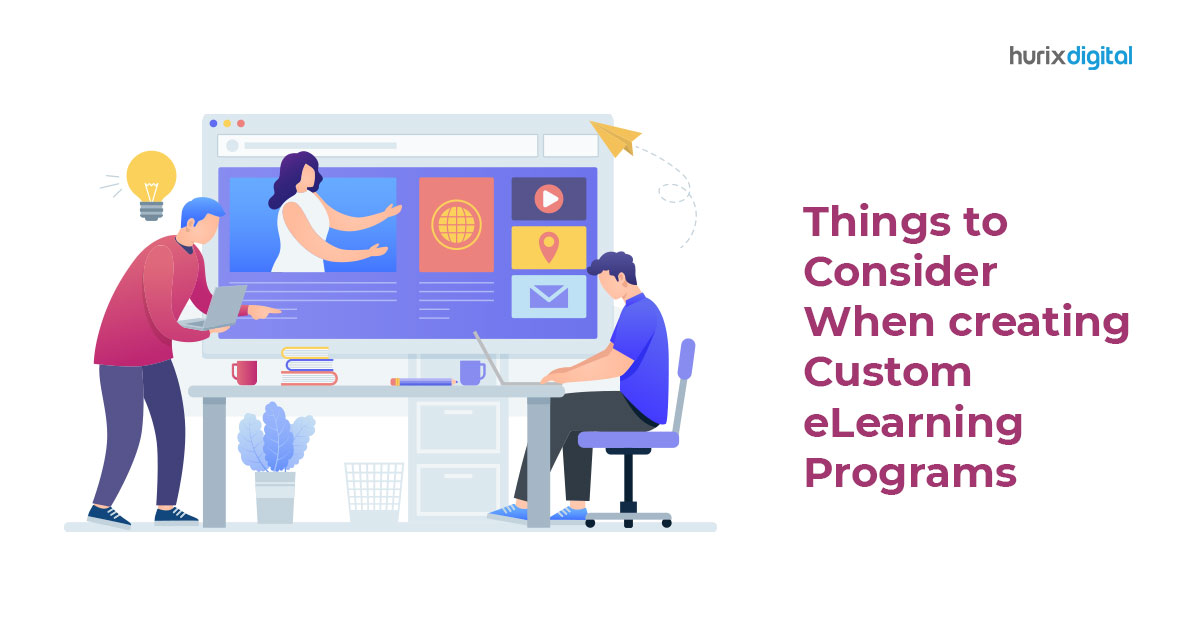
5 Things to Consider When Creating Custom eLearning Programs
Custom eLearning has slowly revolutionized the education sector over the past few years. Several factors have led to this revolution, from ensuring equal access to education for people regardless of their geographical, economic, and social limitations to the changes brought about by the COVID-19 pandemic.
With several new players in the eLearning industry trying to make their presence felt, this form of learning must be disseminated correctly while ensuring that it’s as effective and democratic.
While various models can be adopted when creating a custom eLearning program, you must choose the right one based on who you plan on targeting and your objectives.
Related Read – How to Find the Best Custom eLearning Services Provider?
This guide will take you through five key factors to consider when creating custom eLearning programs, whether for the K-12 level or organizations. But first, let’s understand the various models one can adopt when designing eLearning programs.
Table of Contents:
- Various Models to Consider When Designing eLearning Programs
- Five Things to Consider in the Creation of a Custom eLearning Program
1. Find the Niche You Intend to Target
2. Thoroughly Define Who Your Target Audience Will Be
3. Define the Objectives You Intend to Achieve
4. Ensure Accessibility for All
5. Create a System for Self-Paced Learning - In Conclusion
Various Models to Consider When Designing eLearning Programs
One can consider several key instructional design models depending on what one intends to achieve with their eLearning courses. Three key models among these are as follows:
- ADDIE – ADDIE stands for Analysis, Design, Development, Implementation, and Evaluation. This model is the most common as it compels designers to focus on and evaluate all aspects of the eLearning process.
- ASSURE – ASSURE stands for Analyzing Learners, Stating Objectives, Select Media and Materials, Utilizing Media and Materials, Requiring Learner Participation, and Evaluating the course. This model assumes that the course design utilizes various forms of media.
- Rapid ISD Model – This model is ideal for those required to design eLearning courses within tight deadlines and budgets and is all about an overall accelerated learning process.
Related Read –Top 5 Instructional Design Frameworks for Higher Education
5 Things to Consider in the Creation of a Custom eLearning Program
1. Find the Niche You Intend to Target
The first aspect one must consider when designing and creating an eLearning program is understanding who you intend to target. The best way to achieve this is via thorough market analysis, by analyzing your potential competitors, how they design their courses, what they offer, and who they target it to.
For instance, if you plan on curating eLearning programs for K-12 students, it’s worth noting that the digital K-12 learning market is projected to grow by $60.03 billion by 2023. This means that this target segment can offer tremendous potential, especially with access to the internet skyrocketing worldwide at a rapid rate.
Then, the next step is to find gaps in your competitor’s solutions to capitalize on, so you can provide something that the others aren’t, thereby differentiating yourself from them. Furthermore, it’s also essential to analyze aspects such as their value propositions, revenue streams, products, cost structure, marketing channels, and more.
Related Read – 7 Best Education Tech(EdTech) Companies for K-12 Institutes in 2023.
2. Thoroughly Define Who Your Target Audience Will Be
With your market research complete, the next step is to define your target audience thoroughly. This will also give you a good idea of what level of information the course must offer. For instance, if you intend to target your programs to schools, you’ll need to introduce introductory levels depending on which years the students will be studying.
On the contrary, courses meant for organizations will likely be more advanced and niche, training employees in key skills required to improve their work performance and industry knowledge. Further, narrowing down your niche will also give you an idea of the methods to disseminate information.
For instance, millennials and post-millennials prefer a more personalized approach, with tools like quizzes, games, and other stimulating activities integrated into their learning. On the contrary, older audiences are more likely to prefer a more straightforward, text-based learning mode.
Lastly, whether or not your target audience has prior experience with eLearning tools will also dictate how the interface is designed. Those accustomed to it are more likely to be able to navigate a more feature-packed interface with greater ease, while those who have mostly relied on a pen-and-paper model will need a much simpler interface.
3. Define the Objectives You Intend to Achieve
The end goal of any endeavor often defines how it’s practiced or implemented, which is key to creating a truly effective eLearning program.
For instance, if your programs are meant for students at the K-12 level or university, they’re more likely to have a mix of theoretical and practical content. This is because students at these levels are most likely being introduced to new concepts for the first time. On the contrary, programs defined for those already a few years into their professional careers are more likely to be practical, as they already have the theoretical foundation needed to add a new skill to their portfolio.
4. Ensure Accessibility for All
Another key aspect of democratizing digital learning is ensuring that your programs can be accessed by people regardless of which device they use or cater to those with disabilities. For instance, while students at a school rely on tablets for their education, employees at an organization are more comfortable with a laptop or computer. Further, someone who intends to access your programs from home might use a mobile phone.
Either way, your interface must be designed to ensure its compatibility with different types of devices and operating systems like iOS, Android, Windows, or Mac. Moreover, ensuring that your programs can be accessed via text and voice or allow for inputs via text-to-speech can go a long way in making your content accessible to those with disabilities. You can also adjust your color contrast, add subtitles to videos, offer captions for images, and more, all of which can make your content more accessible.
5. Create a System for Self-Paced Learning
One thing that’s become evident over the years is that every student learns at a different pace, regardless of age and experience. This is where it becomes essential that your programs allow for a system that will enable its pupils to learn at their speed. This individualization of learning takes into account each student’s traits and cognitive ability to ensure they learn in a manner that appeals to them.
The use of Machine Learning and Artificial Intelligence can go a long way in making this possible. This will become crucial, especially in 2023, as individualized learning is shown to have far better outcomes than personalized learning. The proof of this lies in the fact that more and more students are choosing to learn via self-learning programs, to a point where the global self-paced education market will witness a CAGR of 8.2%.
In Conclusion
The benefits of opting for custom eLearning programs are immense. They are specifically tailored to the target audience’s needs and demands, thus ensuring a high success rate. As with every product, the key is to test your program and open yourself up to feedback from your program’s beneficiaries, so you can further improve your offer.
With Hurix Digital, you get the best custom eLearning content at the K-12 level, higher education, or even for organizational training. In addition, we offer a wide gamut of services, all of which are steadily revolutionizing the eLearning industry. Contact us to learn more.

Senior Vice President – Business Development
at Hurix Digital, with over 25 years of experience in EdTech and workforce learning. He excels in business development, customer relationship management, and scaling digital learning solutions, driving global growth through innovative content, simulations, and AI‑driven training offerings








